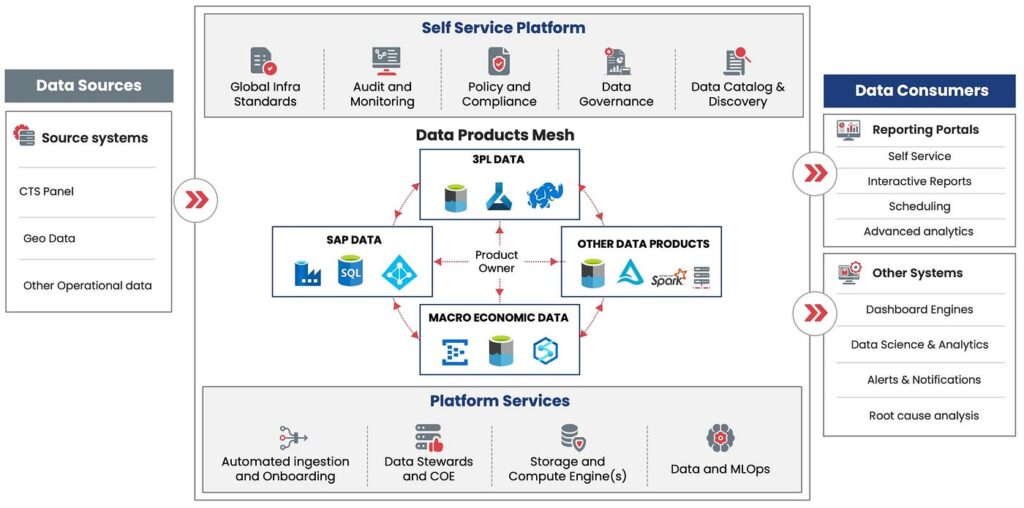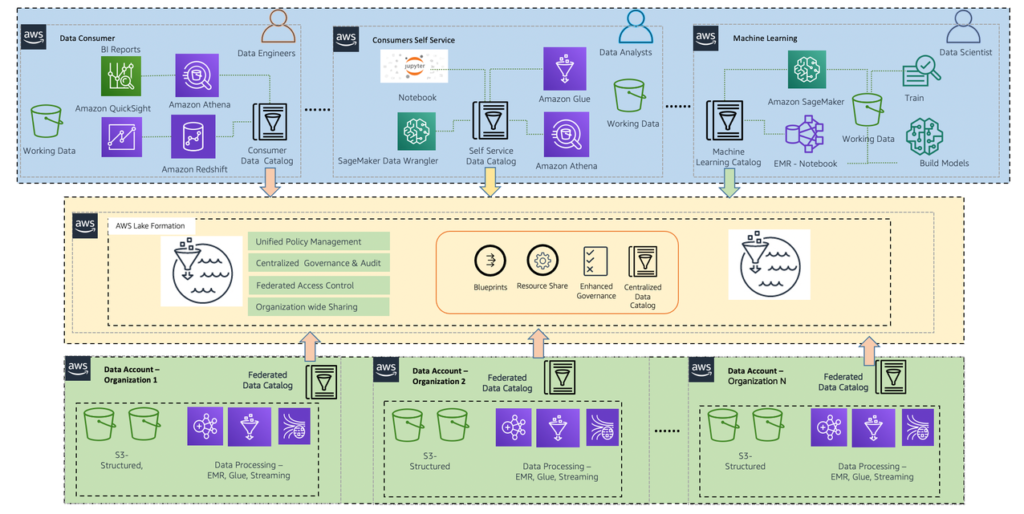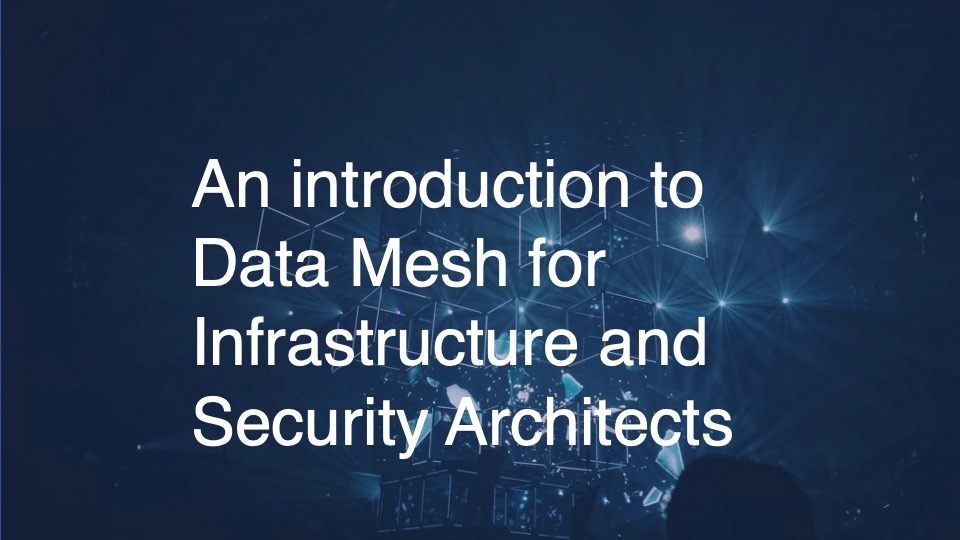I was working with a customer recently and one of the pressing initiatives they have is around the implementation of a Data Mesh architecture/framework within their organisation.
Being the curious individual that I am, I decided to delve into this, new to me, concept of Data Mesh: a transformative approach to data management that is gaining traction across industries, promising to reshape how organizations handle and derive value from their data assets.
Introduction to Data Mesh
- Understanding Data Mesh
Data Mesh represents a fundamental shift in how data is managed within organizations. Unlike traditional centralized data architectures, Data Mesh advocates for a decentralized approach where data ownership and governance are distributed across different domains or business units. This decentralized model aims to address common challenges associated with centralized data platforms, such as scalability issues, siloed data, and limited access to relevant data for decision-making.
- Key Principles of Data Mesh
At the core of Data Mesh are four key principles:
- Data as a product: Data is treated as a product, with clear ownership, quality standards, and documentation.
- Self-serve data infrastructure: Data infrastructure is democratized, allowing domain experts to access and utilize data without heavy reliance on centralized teams.
- Federated governance: Governance responsibilities are distributed to domain teams, who are accountable for data quality, security, and compliance within their respective domains.
- Domain-oriented architecture: Data is organized around business domains, enabling teams to focus on domain-specific data requirements and processes.
- Benefits of Data Mesh
Implementing a Data Mesh approach can yield several benefits for organizations, including:
- Improved data agility and scalability
- Enhanced data quality and governance
- Accelerated innovation and data-driven decision-making
- Reduced time-to-insight and time-to-market for new products and services
- Challenges of Implementing Data Mesh
While the benefits of Data Mesh are compelling, organizations may encounter challenges when transitioning to this decentralized data management model. Some common challenges include:
- Cultural resistance to change and decentralized data ownership
- Technical complexity in implementing data pipelines and integrations
- Ensuring consistency and alignment across domains for data governance and quality
- Impact of Data Mesh on Businesses
Embracing a Data Mesh architecture can have a profound impact on how businesses leverage their data assets. By empowering domain experts to own and manage their data effectively, organizations can unlock new insights, drive innovation, and achieve competitive advantages in a rapidly evolving digital landscape.
Applying Data Mesh to AI
In the realm of artificial intelligence (AI), the implementation of Data Mesh holds significant implications and opportunities for organizations looking to harness the power of AI-driven insights.

- Enhanced Data Quality and Accessibility: Data Mesh facilitates the decentralization of data ownership and management, ensuring that AI models have access to high-quality, diverse data sources across different domains. This approach enables AI applications to leverage a wider array of data for training and inference, leading to more accurate and robust AI outcomes.
- Scalability and Flexibility: By breaking down data silos and enabling domain-specific data platforms, Data Mesh provides a scalable and flexible infrastructure for supporting AI workloads. This agility allows organizations to scale AI initiatives seamlessly and accommodate evolving data requirements without compromising performance.
- Improved Data Governance and Security: Data Mesh architecture promotes data governance best practices by assigning ownership and accountability to domain teams, which aligns well with the principles of responsible AI. Security protocols can be implemented at a granular level, ensuring that sensitive AI data is protected and compliant with regulatory standards.
- Accelerated AI Development and Deployment: With Data Mesh streamlining data access and integration, AI developers and data scientists can expedite the development and deployment of AI models. The seamless flow of data between domains reduces bottlenecks and enhances collaboration, driving innovation in AI projects.
- Empowering AI Innovation: Data Mesh empowers organizations to explore new AI use cases and experiment with large and diverse datasets. This fosters a culture of innovation, allowing businesses to uncover valuable insights, optimize processes, and deliver personalized experiences to customers through AI-driven solutions.
Incorporating Data Mesh principles into AI initiatives not only streamlines data management but also nurtures a conducive environment for AI innovation and growth. By leveraging the advantages of Data Mesh in conjunction with AI technologies, organizations can unlock the full potential of their data assets, drive actionable insights, and stay ahead in an increasingly data-driven world.
Impact on Infrastructure and Security Architects
In today’s data-driven landscape, the emergence of Data Mesh as a transformative data management approach has significant implications for Infrastructure and Security Architects.

- Impact on Infrastructure Architects
Infrastructure Architects play a vital role in designing and implementing the underlying technology infrastructure that supports an organization’s data ecosystem. With the adoption of Data Mesh, Infrastructure Architects face several key considerations and opportunities:
- Scalability and Elasticity: Data Mesh brings a decentralized approach to data management, requiring Infrastructure Architects to design infrastructure that can scale horizontally to support a growing number of domain-specific data platforms.
- Cloud-Native vs Agnostic Architecture: Infrastructure Architects need to balance cloud-native technologies and services with cloud agnostic solutions to build a flexible and resilient infrastructure that can accommodate the distributed nature of Data Mesh.
- Data Pipelines and Integration: Designing and optimizing data pipelines become critical tasks for Infrastructure Architects to ensure seamless data flow between domain-specific data platforms while maintaining performance and security.
- Automation and Orchestration: With the complexity of managing multiple data domains, Infrastructure Architects must focus on automating infrastructure provisioning, monitoring, and orchestration to ensure efficiency and reliability.
- Implications for Security Architects
Security Architects are responsible for implementing robust security measures to protect the organization’s data assets and ensure compliance with data protection regulations. The adoption of Data Mesh introduces unique challenges and opportunities for Security Architects:
- Data Governance and Access Control: Security Architects need to collaborate closely with domain teams to establish data governance policies, access control mechanisms, and encryption standards to safeguard data across decentralized data platforms.
- Data Privacy and Compliance: Ensuring data privacy and compliance with regulatory requirements becomes a critical focus for Security Architects, especially in a distributed data environment where data ownership and access are dispersed.
- Security Monitoring and Incident Response: With data spread across multiple domains, Security Architects must enhance security monitoring capabilities and develop robust incident response procedures to detect and mitigate security threats effectively.
- Secure Data Sharing and Collaboration: Facilitating secure data sharing and collaboration between domain teams while maintaining data integrity and confidentiality requires Security Architects to implement secure data exchange protocols and encryption mechanisms.
- Collaboration between Infrastructure and Security Architects
As organizations adopt Data Mesh, the collaboration between Infrastructure and Security Architects becomes paramount to ensure the successful implementation and operation of decentralized data platforms:
- Cross-Functional Alignment: Infrastructure and Security Architects must work collaboratively to align infrastructure design with security requirements, ensuring that the data architecture meets both performance and security objectives.
- Threat Intelligence and Vulnerability Management: Sharing threat intelligence and coordinating vulnerability management efforts between Infrastructure and Security Architects help proactively identify and address potential security risks in the data mesh environment.
- Resilience and Disaster Recovery: Collaborative efforts are needed to design disaster recovery plans and ensure the resilience of the infrastructure against cyber threats, data breaches, and system failures.
How can Aviatrix help?

Here are three ways that Aviatrix helps with Data Mesh:
- Bridging Data Centers and Cloud Networking: Aviatrix offers a solution designed to bridge the gap between data centers and cloud environments, providing a seamless and secure network architecture. This capability is particularly beneficial for organizations implementing Data Mesh architectures, as it enables reliable and efficient communication between decentralized data platforms and traditional data centres.
- AI-Powered Cloud Networking: Aviatrix’s cloud networking solutions are tailored to support AI initiatives by providing secure and scalable network connectivity. This aligns with the requirements of Data Mesh architectures, where diverse and distributed data sources need to be seamlessly interconnected to enable effective AI processing and analysis.
- Enhanced Security and Compliance: Aviatrix’s cloud network platform offers advanced security features and compliance capabilities, ensuring that data within a Data Mesh architecture is protected and adheres to regulatory standards. This is essential for maintaining the integrity and confidentiality of data as it flows between domain-specific data platforms, supporting the principles of Data Mesh.
Conclusion
In conclusion, the impact of Data Mesh on Infrastructure and Security Architects is profound, requiring a shift towards more agile, scalable, and secure infrastructure and security practices. By embracing the principles of Data Mesh and fostering collaboration between these key roles, organizations can build a robust data ecosystem that empowers data-driven decision-making, innovation, and growth in the digital era.



